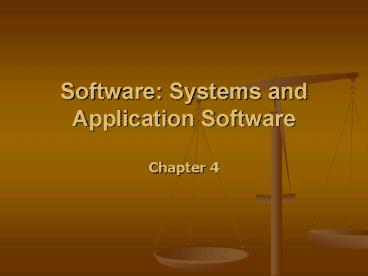Software: Systems and Application Software - PowerPoint PPT Presentation
1 / 56
Title:
Software: Systems and Application Software
Description:
When selecting an operating system, you must consider the current ... Quicken. Word Processing. Spreadsheet Analysis. Database Applications. Graphics Programs ... – PowerPoint PPT presentation
Number of Views:117
Avg rating:3.0/5.0
Title: Software: Systems and Application Software
1
Software Systems and Application Software
- Chapter 4
2
Principles and Learning Objectives
- When selecting an operating system, you must
consider the current and future needs for
application software to meet the needs of the
organization. In addition, your choice of a
particular operating system must be consistent
with your choice of hardware. - Identify describe the functions of the 2 basic
kinds of software. - Outline the role of the operating system
identify the features of several popular
operating systems.
3
Principles and Learning Objectives
- Do not develop proprietary application software
unless doing so will meet a compelling business
need that can provide a competitive advantage. - Discuss how applications software can support
personal, workgroup, and enterprise business
objectives. - Identify 3 basic approaches to developing
applications software and discuss the pros and
cons of each.
4
Principles and Learning Objectives
- Choose a programming language whose functional
characteristics are appropriate to the task at
hand, taking into consideration the skills and
experience of the programming staff. - Outline the evolution of programming languages.
- The software industry continues to undergo
constant change users need to be aware of recent
trends and issues to be effective in their
business and personal life. - Differentiate among the five generations of
programming languages.
5
An Overview of Software
- Computer program - sequences of instructions for
the computer - Documentation - describes program functions
- Systems software - coordinates the activities of
hardware programs - Applications software - helps users solve
particular problems
6
The Importance of Software in Business
7
Supporting Individual, Group, and Organizational
Goals
8
Operating Systems
9
Operating Systems
- Perform common hardware functions
- Provide a user interface
- Provide hardware independence
- Manage system memory
- Manage processing
- Control access to system resources
- Manage files
10
The Role of the Operating System
11
Common Hardware Functions
- Accept keyboard input
- Store data on disks
- Send data to output devices
12
User Interface
- Command-based interfaces
- Graphical User Interfaces (GUIs)
13
Hardware Independence
14
Memory Management
- User Prompts the apps. s/w for specific data
- OS translate this prompt into instruction for h/w
- (which find the data the user request
- Success complete tasks
- OS relays data back to user via apps.software
15
Processing Tasks
- Multitasking - more than one program can run at a
time using a single processor - Time-sharing - multiple users can simultaneously
use the resources of a single processor - Scalability - easy adaptation to more users or
tasks
16
Access to System Resources
- Protection against unauthorized access
- Logins and passwords
17
Personal Computer Operating Systems
18
Personal Computer Operating Systems
19
Workgroup Operating Systems
- Netware
- Windows NT Server 4.0
- Windows 2000 Server
- Unix
- Red Hat Linux
- Mac OS X Server
20
Enterprise Operating Systems
- IBMs OS/390
- HPs MPE/iX (Multiprogramming Executive with
integrated POSIX) - IBMs z/OS
- Linux
21
Consumer Appliance Operating Systems
- Windows CE.NET
- Mobil Linux
- Windows XP Embedded
- Handheld PC
- Pocket PC
- Palm OS
22
Nokia 7650
23
Utility Programs
24
Types and Functions of Applications Software
25
Sources of Software
26
Comparison of Proprietary and Off-the-Shelf
Software
27
Personal Application Software
28
Personal and Application Software
29
Personal and Application Software
30
TurboTax
31
Quicken
32
Word Processing
33
Spreadsheet Analysis
34
Database Applications
35
Graphics Programs
36
On-Line Information Systems
37
Software Suite
38
Major Components of Leading Software Suites
39
Workgroup Application Software
- Groupware
- Collaborative computing software
40
Group Scheduling
41
Examples of Enterprise Application Software
42
Enterprise Application Software
43
Selected Enterprise Resource Vendors
http//www.sap.com/index.aspx
http//www.peoplesoft.com/corp/en/public_index.jsp
J.D. Edward now merged with PeopleSoft
44
Programming Languages
- Commands and statements combined according to a
particular syntax - Different languages have different characteristics
45
Programming Languages
46
First-Generation Languages
- Machine language
- ASCII (American Standard Code for Information
Interchange)
47
Second-Generation Languages
- Assembly languages
- Assemblers
- Symbolic language
48
Third-Generation Languages
49
Fourth-Generation Languages
- 4GLs
- Programs tell the CPU the desired results, not
how to get them - Examples
- SQL, for database queries and manipulation
- - SAS, EC shopping cart
50
Fifth-Generation Languages
- 5GLs
- Uses a visual or graphical development interface
to create source language - Examples Visual Basic, PC COBOL, and Visual C
51
Object-Oriented Programming Languages
- Objects - data and actions that can be performed
on the data - Encapsulation - group items into an object
- Polymorphism - one procedure can work with
multiple objects - Inheritance - an object in a particular class
gets attributes of that class
52
Object-Oriented Programming Languages
53
Software Issues Trends
- Software bugs
- Open source software
- http//opensource.mampu.gov.my/
- http//www.my-opensource.org/oss-faq.htmlq1
- Software licensing
- Software upgrades
- Global software support
- Antitrust issues for software
54
How to Deal with Software Bugs
55
Summary
- Software - consists of programs that control the
workings of the computer hardware - Operating system - set of computer programs that
controls the computer hardware - Application - software that applies the power of
the computer to solve problems and perform
specific tasks - Programming languages - provide instructions to a
computer to perform some processing activity
56
Exercise Chapter 4
- Differentiate between application software and
system software. Your explanation should includes
function of the software and a few examples. - What is Operating System and discuss the various
type of OS































